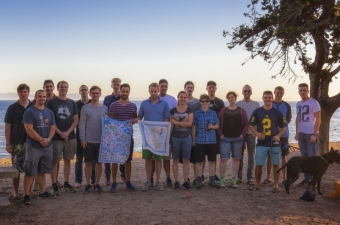
In September, the greatest minds working in the field of ammonothermal growth of single crystals came together at UCSB for the conclusion of a two-session international workshop. The first session was held in Germany, at Friedrich-Alexander-University of Erlangen-Nüremburg (FAU), towards the beginning of the summer, and covered fundamentals of crystal growth and in-situ technologies, which characterize the crystal and the solution from which it grows. Largely coordinated and organized by UCSB Materials alumnus Siddha Pimputkar, Ph.D. 2012, and his colleague Anna Kimmel at FAU, the workshop has the distinction of being the first one held on the topic of ammonothermal growth.
In the second session, held at UCSB, the twenty or so workshop attendees, about half of whom were international, attended lectures and ammonothermally grew and characterized single crystal gallium nitride (GaN). Entrepreneurs from Santa Barbara presented their work on ammonothermal growth while professors from UCSB and other universities spoke about growth and morphology, the effects of defects, and optical characterization. Of note, Nobel Laureate and UCSB Materials professor Shuji Nakamura described his journey to the Nobel Prize and highlighted the importance of equipment design and the acquisition of fundamental scientific understanding prior to the pursuit of a sellable device.
Using an ammonothermal reactor to grow a single crystal of GaN was a critical opportunity for the workshop attendees and allowed them to gain valuable experience in crystal growth. To launch the session at UCSB, the participants were introduced to a reactor and learned how to prepare, load, fill, and properly execute a run. While crystals were growing, characterization was performed on previously grown crystals using X-ray, SEM, and structural and optical characterization. To conclude the session, the single crystal GaN the workshop attendees grew was unloaded from the reactor. The experience of using an ammonothermal reactor to grow a single crystal was a first-time, and extraordinary, experience for many of the attendees.
Perhaps the most critical event at the workshop was the lecture on ammonothermal growth safety presented by Siddha. Ammonothermal growth involves dissolving a metal in ammonia, much like sugar is dissolved in water, in a system requiring a pressure of around 3000 atmospheres (the pressure in a stove top pressure cooker is around two atmospheres) and a temperature of about 600 degrees Celsius. Siddha addressed the numerous aspects that need to be considered during ammonothermal growth, including the toxicity of ammonia and stored energy in the system (approximately one stick of dynamite for a two-inch reactor).
The workshop session help at UCSB was far from a purely academic exercise. During the evenings, the workshop attendees enjoyed all of the delights Santa Barbara offers. They spent time at the beach, hiked Inspiration Point, and barbequed several tri-tips. Of course, no workshop involving Prof. Nakamura is complete without a dinner at his favorite restaurant, Itsuki. Of all the extracurricular activities, kayaking the caves at the Channel Islands, which allowed time to connect with one another, resonated the most with the attendees. Overall, of the workshop, one of the attendees said, “10 for 10, I would do it again!”
The workshop, funded by the Bavaria California Technology Center (BaCaTeC) and the UCSB Materials Department, provided graduate students, researchers, professors, and entrepreneurs the opportunity to build collaborations between UCSB, Lehigh University, where Siddha recently joined the faculty, and German universities. While the dual-session workshop was the first of its kind for ammonothermal growth, the intent is to continue the workshop every two years. After all, meeting people face to face and gaining practical experience in a research setting is the best avenue to learning.



